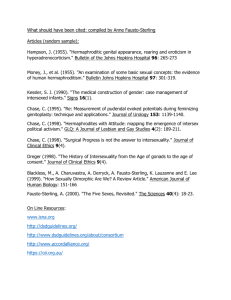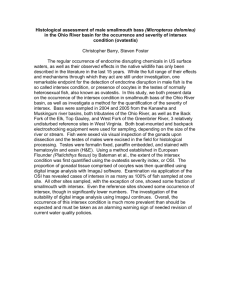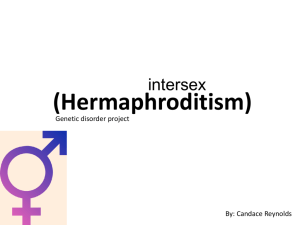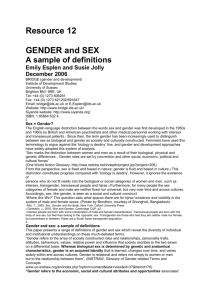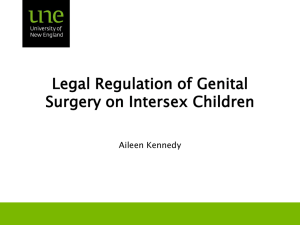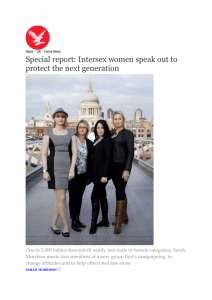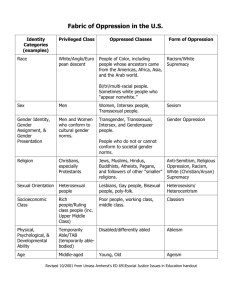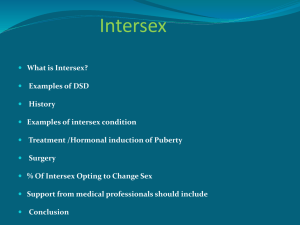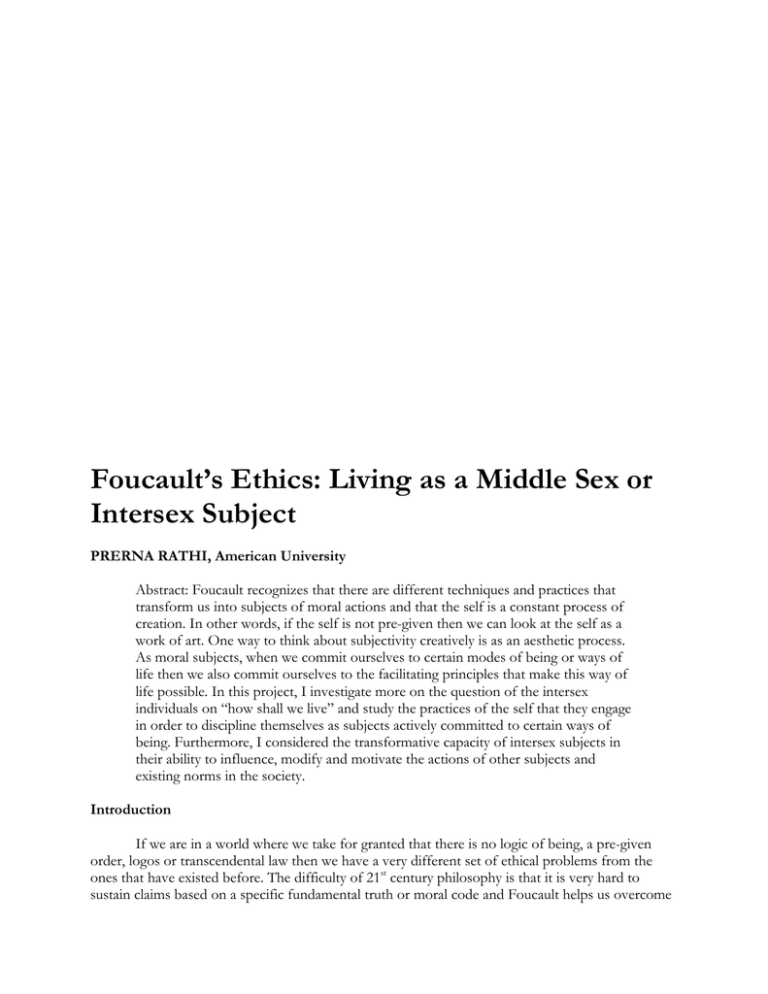
Foucault’s Ethics: Living as a Middle Sex or
Intersex Subject
PRERNA RATHI, American University
Abstract: Foucault recognizes that there are different techniques and practices that
transform us into subjects of moral actions and that the self is a constant process of
creation. In other words, if the self is not pre-given then we can look at the self as a
work of art. One way to think about subjectivity creatively is as an aesthetic process.
As moral subjects, when we commit ourselves to certain modes of being or ways of
life then we also commit ourselves to the facilitating principles that make this way of
life possible. In this project, I investigate more on the question of the intersex
individuals on “how shall we live” and study the practices of the self that they engage
in order to discipline themselves as subjects actively committed to certain ways of
being. Furthermore, I considered the transformative capacity of intersex subjects in
their ability to influence, modify and motivate the actions of other subjects and
existing norms in the society.
Introduction
If we are in a world where we take for granted that there is no logic of being, a pre-given
order, logos or transcendental law then we have a very different set of ethical problems from the
ones that have existed before. The difficulty of 21st century philosophy is that it is very hard to
sustain claims based on a specific fundamental truth or moral code and Foucault helps us overcome
these challenges by reinterpreting ethics. The absence of a logic of being or pre-given order means
that we can construct our own ethics in relation to ourselves. For Foucault, ethics is “how the
individual is supposed to constitute himself as a moral subject of his own actions1” and closely
focused on the question of how to live. Foucault’s insight on ethics and the “work of the self on the
self” with constant self-reflection allow for subjects to develop different relations with themselves
and also with other subjects.
In this ethical project, I am going to examine how Foucault’s idea of ethics provides us with
new lenses to understand the dynamics of gender binary, anatomical “abnormality” and to analyze
middle sex or intersexuality as a way of life. Often, intersex individuals and hermaphrodites have
rejected ontological premises of divine law, natural order, cosmological structures, rational and
scientific rules while resisting dominant practices in their given discourses. These individuals have
time and again challenged concepts of normality, opened up new field of possibilities, dislocated
their previous practices, gained mastery over the self and aspired to attain certain modes of being as
subjects as well as agents of their own actions. Furthermore, in this project, I propose that the
practices of intersex subjects work as exemplars for the techniques deployed by other subjects in reconstituting their own subjectivity in new ways. The intersex community – by reflecting on the
existing discourses and systems of our contemporary culture – is transforming and evolving the
entire system itself, expanding freedom and paving the path to explore new power-knowledge
relationships and networks.
Creative Exploration of How Shall We Live
Foucault recognizes that there are different techniques and practices that transform us into
subjects of moral actions and that the self is a constant process of creation. In other words, if the
self is not pre-given then we can look at the self as a work of art; additionally, for Foucault, ethics is
closely related to an open-ended, heterogeneous system of creativity. One way to think about
subjectivity is as an aesthetic process. As moral subjects, when we commit ourselves to certain
modes of being or ways of life then we also commit ourselves to the facilitating principles that make
this way of life possible. These principles or practices of the self are “models that he finds in his
culture and are proposed, suggested, imposed upon him by his culture, his society and his social
group2”. In this project, I investigate the question of intersex individuals on “how shall we live” and
study the practices of the self in which they engage in order to form themselves as subjects actively
committed to certain ways of being. I also analyze the ways in which culture, society, and other
subjects have influenced the practices and moral actions of intersex subjects.
Overall in this project, I explore personal narratives, documentaries, academic research,
medical approaches, international legal studies in the field, and historical backgrounds to gain greater
depth on the topic of anatomical differences and intersexuality. I apply Foucault’s insights in the
discourse of sexuality, self-care, and his ethical approach to re-examine the notion of the middle sex,
existing practices that deal with anatomical differences, frequency of intersexuality, health and legal
implications of the current approaches, paradigm shift and resisting practices as well as promoting
alternative ways of being in the context of our discourses. Furthermore, I consider the
transformative capacity of intersex subjects in their ability to influence, modify, and motivate the
actions of other subjects and existing norms in the society.
1 Foucault, Michel, and Paul Rabinow "On the Genealogy of Ethics" In Ethics: subjectivity and truth. New York: New
Press, 1997. 263.
2 Ibid (The Ethics of the Concern for Self as a Practice of Freedom, 291)
Foucault’s Ethics
“Ethics should focus on the work of the self on the self…the self taking itself
as a work to be accomplished, an ethics that is no longer supported by either
traction or reason… as an artist to itself, the self would enjoy the autonomy
that modernity can no longer do without.”3
Our relationship with the self requires constant reflection and conscious action with the
vision of the world that we are trying to create. Foucault argues that the relationship to oneself has
four major aspects, which include ethical substance, mode of subjectivation, ethical work, and telos.
The first aspect answers the question: Which is the aspect or part of myself or my behavior
that is concerned with moral conduct?4 The ethical substance is the part of an individual concerned
with moral conduct or appropriate behavior and ethical judgment. For instance, in our society the
main field for morality is our feelings. In this project, the study of the intersex community further
validates that subjects usually rely on their feelings for ethical conduct and judgment.
The second aspect is the mode of subjectivation, that is, the way in which people are invited or
incited to recognize their moral obligation5. The mode of subjectivation reveals what fundamental
law or truths (such as natural or divine law, rational rule and cosmological order) to which the
subject ascribes. For example, the intersex subjects deny and challenge the common culture’s
assumption on how gender seems natural (or necessary) and reveal the arbitrariness of our invented
terms such as gender, anatomy and sex.
The third aspect asks what are the means by which we can change ourselves in order to
become ethical subjects?6 It is the practice of the self, self-forming activity, and ethical work that the
subject works on, improves, critiques and becomes engaged in re-writing its subjectivity in new
ways. Some examples of what we do are: moderate our actions, eradicate our desire, use our sexual
desire in order to obtain certain aims or decipher what we are. Intersex subjects seem to engage in
deciphering what they are and reflect on that.
Lastly, the fourth aspect answers the question of the telos: which is the kind of being to which
we aspire when we behave in a moral way?7 For instance, shall we become pure, or immortal, or
free, or masters of ourselves, and so on? The intersex community’s orientation and aspiration is to
become free and resist the dominant practices in our current discourses.
Understanding the Notion of the Middle Sex
“Such [hermaphrodite] creatures seem to have been formed merely to show
us that this much-talked-of-difference of sex is, after all, nothing inherent in
the constitution of things, and that individuals may be born, live, and thrive of
both sexes or neither.”8
3 3 Foucault, Michel, and Paul Rabinow "On the Genealogy of Ethics" In Ethics: subjectivity and truth. New York: New
Press, 1997.
4 Ibid (263)
5 Ibid (264)
6 Ibid (265)
7 Ibid (265)
8 Napheys, George H.. The physical life of woman: advice to the maiden, wife, and mother. Enl. and rev. ed. Philadelphia: G.
Maclean; 1870. Print. (This quote shows how intersexuality- as a case where anatomy does not fit the existing gender
Society and different discourses usually strengthen themselves by creating identities and
distinct categories to ensure enhanced interactions and bonds between the different members tied
together by a string of certain similarities. Often, anatomy or body structure act as means of
categorizing people and influences the assumptions and judgments that others make on the basis of
physical appearances and sexual characteristics. Anatomical restrictions have been traditionally
unwritten and over time transformed into written rules or even standards governing our societies.
For example, privileged status based on birthrights, controls on who can vote, and marriage
regulations determining who can marry whom illustrate some of the ways in which anatomy have
historically dictated our actions9. The liberal progression towards “all men are created equal” is itself
an anatomical truth claim that allows people to vote and enjoy certain unalienable rights regardless
of whether they are men or women10! But then questions arise about the foundations and premises
of this assumption that has limited the society to conventionally discriminate and eventually
institutionalize equality between two categories of gender, males and females. What about
individuals born with both male and female sexual characteristics? How are these intersex or middle
sex individuals considered abnormal and anatomically deformed only because they seem different?
How does swinging in a gender binary eventually become a way of life and a new model for other
subjects in our society?
In Foucault’s words, “power is essentially what dictates its law to sex11”. Firstly, this implies
that sex is placed by power in a binary system such as licit and illicit, or permitted and forbidden.
Secondly, power prescribes an “order” for sex, which also implies that sex is deciphered on the basis
of its relation to the law12. Thirdly, power acts by laying down the law: “power's hold on sex is
maintained through language, or rather through the act of discourse that creates, from the very fact
that it is articulated, a rule of law. It speaks, and that is the rule13.” Thus, the norms and practices of
the common culture decide and shape what is acceptable or normal as opposed to unacceptable or
abnormal in our everyday lives. In our contemporary culture, anatomy is connected to gender.
Anatomy consists of physical features and we assign names and meanings to these body parts.
Furthermore, we declare what organs are the markers of our sexual identity. We also invent the idea
of gender and hang it on to anatomy, which makes the concept of gender seem natural14. In sum,
gender is the consolation of practices that assume and result in a binary differentiation of human
beings. Ultimately, all of these terms (anatomy, gender, sex) depend on their constructed meanings
within the system of our culture. Foucault’s lenses on ethics give us an opportunity to identify how
these are contingent and random terms which get connected and intelligible within a culture in
specific ways. In Paul Veyne’s words, “what is called a culture has no unity of style; it is a mish-mash
of rigorously interpretable discursive practices; it is a chaos of precision15.” Over time, when specific
binary- provides our culture with a new lens to recognize and examine how gender is constructed in our discourse of
practices).
9 Dreger, Alice Domurat. One of us: conjoined twins and the future of normal. Cambridge, Mass.: Harvard University Press,
2004. Print.
10 Ibid
11 Foucault, Michel. "Objective." The history of sexuality. New York: Vintage, 1990. 83. Print.
12 Ibid
13 Ibid
14 Kessler, Suzanne J.. Lessons from the intersexed. New Brunswick, N.J.: Rutgers University Press, 1998. Print.
(Clarifications on terms related to gender:
Gender attribution: The gender others in the social world perceive you as being (female or male)
Gender identity: One’s sense of oneself as belonging to either the female or male category
Gender role: Cultural expectations of behavior as appropriate for female and male)
15 Veyne, Paul. The Final Foucault and His Ethics. Foucault and his Interlocutors. Edited by Arnold I. Davidson. Chicago: The
University of Chicago Press, 1997. 228.
sets of practices and discourses under the umbrella of culture become dislocated or displaced in new
ways then it further shakes the entire system of our culture.
The shaking-of-the-culture unfolds the arbitrariness and indeterminism of the whole system
and the meanings we construct or the practices we follow cease to make sense anymore. Similarly,
intersex subjects - with atypical anatomy - challenge the foundations of the system of our culture
and the interwoven discourses forming it. The norms, discourses, and previous practices that
seemed to fit together in a natural or normal way in our society get exploded when an intersex
individual does not “fit in” and shows us the contingency and uncertainty in our system. Society tries
to normalize these intersex individuals so that the whole system can work again in the normal order
as before. However, the intersex community at present is resisting the existing system and is opening
up doors for this system to evolve into a new one.
In our culture, part of the meaning of being a man is that he desires a woman and likewise,
part of the meaning of being a woman is that she desires a man. Thus, heterosexual desires are
naturalized in the gender binary by stating that the masculine and feminine organs and genitalia fit
together in a complete sense16. Moreover, the existence of these organs implies that each gender
desires the opposite one. In the twentieth century, there was a shift on basing gender-assignment
decisions from whether the gonads had reproductive potential to how the genitals could best be
used heterosexually17. Thus, an important factor of the anxiety of parents of intersex children is that
their children do not fit into what it implies to be in a normative heterosexual relationship. If the
intersex community challenges the idea of heterosexuality then it also unsettles the intertwined
threads of gender, anatomy, and sex with it. For example, in our current discourse, the requirements
for males are: “the presence of a sufficiently large phallus to function as a male urinary conduit, to
offer a satisfactory appearance when compared with peers, and to function satisfactorily for sexual
activity18.” Assuming that the order is not arbitrary, the penis is, first of all, for one’s health, as a
technical means for passing liquid waste out of the body; secondarily, it is for one’s male friends to
view in the locker and to validate one’s masculinity; lastly, it is for sexual pleasure19. Intersex subjects
do not fit into the schema of either the traditional male or female requirements and attempt to
change this schema under which we are operating.
Existing Practices to Deal with Anatomical Differences (Specifically Intersexuality)
“If genitals are not completely dimorphic, if genital surgery to create dimorphism
is problematic, and if people under certain conditions are capable of accepting
genital variability, then why is intersexuality managed in the way that it is?”20
Susan Kessler cited above interestingly argues in a Foucauldian style- “For the purpose of gender assignment, males
and females do not necessarily need physical genitals but rather cultural genitals (the genitals that the cultural system
assumes one to have behind one’s clothes)”
17 Creating genitals in one gender for the purpose of the other is illustrated in a conversation between a genitallymutilated woman and her mutilator in Alice Walker’s Possessing the Secret of Joy (New York: Pocket Star Books, 1992). The
woman whose clitoris and labia were cut accuses the elder, “I felt I have been made into something other than myself.”
The elder replies, “You have been made into a woman… It is only because a woman becomes a woman that a man
becomes a man” (246).
18 Hendricks, Melissa “Is it a Boy or a Girl?” John Hopkins Magazine 45, no. 5 (November 1993): 10-16
Newman, Kurt, Judson Randolph, and Kathryn Anderson. “The Surgical Management of Infants and Children with
Ambiguous Genitalia.” Ann. Surg. 215, no.6 (June 1992): 644-653
19 Ibid
20
Lessons from the Intersexed
16
Newborns are typically classified into one of the two genders and those born with anatomies
that don’t fit the social norms are subject to medical intervention or normalization surgeries to
modify the child’s genitalia and reinforce the gender decided upon by the doctors, parents and the
society. Often, there exists a gap between what others think is best for the intersex child and what
the child thinks is best for him/herself21. The child is somewhat a victim (as described by the
intersex adults) of the doctors and parents who seldom oppose the restricted medical and legal
standards to fix intersex conditions. Doctors attempt to surgically improve the child’s appearance by
completely changing their body structures and hormones but do not take into consideration any of
the ways in which these actions inhibit a healthy adaptation and psychological well-being for these
children22. In fact, the medical intervention increases the long-term implicit costs such as bleeding,
infection, insecurity, and adverse clinical consequences to achieve the short-term benefit of creating
a normal body. From the physician’s point of view, gender assignment or surgical techniques are
controversial, but the existence of intersex bodies and the need to treat them are not23.
Furthermore, with an increase in technological development and a continual demand of
more technology for the purposes of cosmetic or reconstructive surgery and other ideal or aesthetic
intentions in the present era, surgeries ultimately reduce variability by setting narrower ranges for
what is considered acceptable in the society. In other words, the various technological efforts have
been marshaled by the medical profession to reduce variability within each gender and to increase
differences between the two genders24. The intersex community is currently questioning whether
broader standards for genitalia will be adopted gradually and if more “abnormal” infants will be
excused from surgery or would the opposite occur? As of now, the rise in genital surgery has led to
less tolerance for variability rather than more tolerance. Intersex subjects are attempting to explore
what moves have not been made yet in the current discourses and practices in order to expand their
own freedom while indirectly opening up new field of possibilities for other subjects in the society.
The doctors demonstrate an unwillingness to think about intersexuality in any other terms
except within that of existing practices in biomedical discourses, and they influence the thoughts and
practices of the parents as well. Often, doctors mistake the silence of their patients as satisfaction
and rarely conduct surveys or research to inspect the repercussions of their clinical procedures.
“Shame produces silence, silence condones surgery, and surgery produces more shame,” stated
Tamar-Mattis,25 to show the vicious cycle of the genital surgeries. Instead of helping the intersex
children, the doctors influence the decision makers and income holders (parents) to accept their own
children by changing their bodies. In reality, the intersex kids do not want any changes made to their
bodies because it does more harm than good26. In their quest for normalcy, the doctors perform an
indirect genital mutilation and psychological harm to the intersex individuals.
How Is the Case of Intersexuality Different from Other Cases?
“Genital variability [intersexuality] can continue to be seen as a condition to be
remedied or in a new way – as an expansion of what is meant by female or male.
Whether the meaning one imparts to genital variability reifies gender or trivializes
it has important implications for gender and intersex management. We need to
As seen in- Eugenides, Jeffrey. Middlesex. New York: Farrar, Straus, Giroux, 2002.
"Intersex." Homepages at WMU. http://homepages.wmich.edu/~bstraigh/AN120/AN120visuals/Intersex.
23 Karkasis, Katrina. Fixing sex: Intersex, Medical Authority and Lived Experience. Durham: Duke University Press, 2008.
24 Kessler, Susan. Lessons from the Intersexed
25 Tamar-Mattis, Anne. Exceptions to the Rule: Curing the Law’s Failure to Protect Intersex Infants, 21 Berkeley Journal of
Gender, Law & Justice 59 (2006).
26 Alderson, P.1993. Children’s Consent to Surgery: Buckingham: University Press.
21
22
consider different possibilities about how to manage intersexuality, including the
possibility of not managing it at all.”27
As seen above, unlike cosmetic and reconstructive surgeries, genital-normalizing surgery is
not undertaken for pleasure, but it has long-term consequences and repercussions on the future of
the intersex children. Also, clinical procedures may exacerbate the lives of the intersex kids. For
example, genital surgery may result in a loss of reproductive capacity, chronic infections, scarring
and urinary incontinence (ISNA). Often, courts and legal institutions assume that the choices of the
parents can be equated to the best interest of the children and let them take decisions for their kids.
Parental consent is successful in case of other surgeries where parents have complete information
and knowledge of what actually is beneficial for their children. However, in case of intersex kids,
parents have incomplete and misleading information and no personal experience or specialist
counseling to determine what actually serves the well-being of their children28. Should the parents
allow the doctors to infringe upon their kids fundamental rights? Do they just sit and refrain from
any medical intervention? Only the intersex children, who can feel and comprehend their own
senses, muscles, organs and bodies, can answer these questions with a greater possibility of
improving their conditions rather than simply letting their parents and doctors risk their choices and
experiment on them29. Hence, intersexuality is different from other cases because of the rarity of this
case and inadequate information (often ignorance) on how to handle the physical and psychological
balance and basic health of the patients.
Frequency of Intersexuality
“Destabilizing gender introduces more selection bias in [the] data and arguments
than people such as myself can afford, since we are trying to accomplish
associations and determinants in the context of what is rather than what should be.
Professionals need to see themselves not only as constrained by real world
demands but as creators of that world.”30
Aside from the issues with the surgeries and medical treatments, ethicists and diverse
researchers ignore the question of intersex treatment because they assume the phenomenon of
intersexuality to be extremely rare. The estimates show that 1 in every 1500 live births include
intersex kids (Dreger). However, the measurements to determine the intersex conditions are
ambiguous and often misleading. The intersex kids are somewhat marginalized because of their
small numbers and this also explains the lack of a more humane and enhancing treatment within the
medical community. In fact, children treated for intersex conditions within the medical
establishments sometimes experience many of the same types of trauma as children who are sexually
abused31. Currently, the intersex community – similar to Foucault’s archaeological approach – is
interested in exposing the power-knowledge dynamics of their current discourses and to target
practices strategically in order to change the existing practices of normalization.
Lessons from the Intersexed
Karkasis, Katrina. Fixing sex: Intersex, Medical Authority and Lived Experience. Durham: Duke University Press, 2008.
29 XXY. DVD. Directed by Lucia Puenzo. New York: Film Movement ; 2008.
30 Kessler, Susan. Lessons from the Intersexed. (The psychologist is attempting to open up more possibilities for the future
with creativity, imagination and enable new ways of rewriting our subjectivity).
31 “Intersex” Homepage (as cited earlier)
27
28
Intersex Subjects Engaging in the Care of the Self
“He [Socrates] is the man who cares about the care of others; this is the
particular position of the philosopher. But let me say simply that in the case of
the free man, I think the postulate of this whole morality was that a person who
took proper care of himself would, by the same token, be able to conduct
himself properly in relation of others and for others. A city in which everybody
took proper care of himself would be a city that functioned well and found in
this ethical principle of its permanence.”32
The medical treatment of intersex infants may have profound legal implications for the
intersex patients upon reaching adulthood. The well-meaning parents and doctors are unable to
weigh the risks and benefits of surgery because of their own biases and fear of sexual differences. In
Foucault’s words, at least in our industrialized and fast-paced society, “parents are denounced as the
real culprits for the lack of supervision, neglect, and, above all, lack of interest in their children, their
children’s bodies, and their conduct which leads them to entrust their children to wet nurses,
domestic servants, tutors…Furthermore, there is an emergence of the health principle as a basic law
governing family ties; the distribution of the family cell around the body – and the sexual body – of
the child33”. Likewise, as seen in the case of intersexuality, parents are extremely involved in the
sexual health concerns of their kids. Doctors focus on the perceived need of the parents to have a
“normal” infant rather than on the actual needs of the child as it grows into adulthood. Parents
comply with the doctors’ to fix the anatomical problem than to question whether these efforts are
truly in the child’s (or potential intersex individual) best interest34. Often, the only approachable
solution (surgery and clinical procedures) to deal with intersex conditions – the inability to envision
a happy, productive life for a visible intersex person – is both the cause and consequence of the
surgical “erasing” of intersex bodies (Tamar-Mattis). Hence, the decision-making process of both
the doctors and parents fail to protect the interests of the intersex children. In fact, many times
medical intervention leads to sterilization and prevents the individual from the right to procreation35.
Engaging in a genealogy of the relation between self-knowledge and self-care, Foucault
writes, “The care of the self isn’t another kind of pedagogy; it has become permanent medical care.
Permanent medical care is one of the central features of care of the self. One must become the
doctor of oneself36.” Similarly, the intersex subjects are attempting to gain the right to become
doctors of the selves rather than let the parents and doctors make the medical decisions for them. At
present, the intersex individuals are fighting to have the right to determine their decisions with
complete information from education and dialogue with other patients to ensure a valuable longterm choice and overall well-being. Foucault also stresses the relational aspect of the care of the self.
He highlights,
“The care of the self is ethical in itself; but it implies complex relationships with others
insofar as this ethos of freedom is also a way of caring for others…care of the self also
implies a relationship with the other insofar as proper care of the self requires listening to
The Ethics of the Concern for Self as a Practice of Freedom, 287
The Abnormals, 54
34 Preves, Sharon. "Negotiating the Constraints of Gender Binarism: Intersexuals' Challenge to Gender Categorization." Current
Sociology. http://csi.sagepub.com/content/48/3/27.full.pdf+html (accessed December 3, 2012).
35 Ibid
36 Foucault, “Technologies of the Self”.
32
33
the lessons of a master. One needs a guide, a counselor, a friend, someone who will be
truthful with you. Thus, the problem of relationships with others is present throughout the
development of care of the self.”37
Until recently, different intersex individuals (especially the children and youth) had no
communication or connection with other people who have similar intersex conditions. In fact, the
lack of others’ insights and narratives had often left the parents and intersex children vulnerable to
the pressure of the doctors and medical community. The intersex subjects had no other positive
models and alternatives, in the previous years, to consider due to lack of sufficient information and
sharing of the available medical records with others who are born with similar anatomical
conditions38. Recently, the intersex community, with an awareness of self-care, has connected with
psychologists, counselors, researchers, schools, local institutions, and NGOs from different nations
to interact and enable the sharing of resources, experiences, dialogues and learning. Also, for
Foucault, taking care of oneself is also to know oneself and to have knowledge “of a number of
rules of acceptable conduct or of principles and prescriptions39.” The intersex community is further
pressing for the acceptable principles or international law to change for the case of intersex
individuals and allow intersex children (especially on reaching the age of puberty) to be recognized
as the main decision-makers on issues specifically related to their own health and well-being40.
The Need to Create New Kinds of Freedom and Possibilities
“Ethics is the considered form that freedom takes when it is informed by
reflection…Extensive work by the self on the self is required for this practice of
freedom to take shape in an ethos that is good, beautiful, honorable, estimable,
memorable, and exemplary.”41
On May 27, 2004, the San Francisco Human Rights Commission held its first public hearing
on intersex concerns in the U.S. The hearing extended for over four hours and declared intersex as a
human rights issue42. The Commission issued a Human Rights Investigation into the Medical
“Normalization” of Intersex People and claimed that the standard medical approach to treat intersex
conditions leads pediatrics to violate their patients’ human rights43. Additionally, Cheryl Chase, an
intersex patient and the executive director of the Intersex Society of North America (ISNA),
emphasized, “no longer should we be lied to, displayed, be injected with hormones for questionable
purposes, and have our genitals cut to alleviate the anxieties of parents and doctors. Doctors’ good
intentions and motivations are not enough. Practices must now change44.” Most of the hearings
37 Michel Foucault, “The Ethics of the Concern for Self as a Practice of Freedom,” Ethics, Subjectivity and Truth, ed. Paul
Rabinow, (New York: The New York Press, 1994), 287.
38 "Videos." Intersex Society of North America | A world free of shame, secrecy, and unwanted genital surgery.
http://www.isna.org/videos
39 Michel Foucault, “The Ethics of the Concern for Self as a Practice of Freedom,” Ethics, Subjectivity and Truth, ed. Paul
Rabinow, (New York: The New York Press, 1994), 285.
40 Ibid
41 Michel Foucault, “The Ethics of the Concern for Self as a Practice of Freedom,” Ethics, Subjectivity and Truth, ed. Paul
Rabinow, (New York: The New York Press, 1994), 284-286.
42 "San Francisco Human Rights Commission Hearings." Intersex Society of North America | A world free of shame,
secrecy, and unwanted genital surgery. http://www.isna.org/videos/sf_hrc_hearing
43 Ibid
44 "Cheryl Chase (Bo Laurent)." Intersex Society of North America | A world free of shame, secrecy, and unwanted genital
surgery. http://www.isna.org/about/chase
specifically condemned the continued clinical practices of performing irreversible normalizing
surgeries without the patients’ consent, misguiding parents with minimal information about
intersexuality, withholding the patients’ medical records and failure to provide any counseling to
support people with psychological trauma. In fact, the American surgeons seemed to violate their
vowed ethical duty to do no harm45.
The American Academy of Pediatrics (AAP) forwarded its policy statement on the
evaluation of newborns with abnormal genitalia, in response to the Human Rights Commission, and
it calls the birth of an intersex child “a social emergency” with a sense of urgency to conduct genital
surgeries at an early age46. However, recently a number of physicians and patients in the U.S
Commission Hearings suggested the need to delay the reconstructive surgeries until the intersex
individual is able to participate in the decision making process. The intersexual movement in the
U.K. has achieved greater success in expanding freedom and opening a new field of possibilities
while also involving multiple players in the society and has served as an exemplary model for the
intersex community in the U.S. Children have more rights to confidential information and to make
treatment decisions in countries that provide free-state services, such as the U.K, where the parents
do not necessarily pay directly for the kids’ healthcare because the state provides it47. Thus, in the
U.K, the “Children Act 1989” states that ‘if the child is of sufficient understanding (usually at the
age of 16 or even younger) to make an informed decision he may refuse to submit to a medical or
psychiatric examination or other assessment48’. There are different controversies based on these
policies but at least the English law recognizes that the parents’ consent to the medical system can
often override a competent child’s refusal49. The U.S still sticks to the 18 years age limit for children
to make their own decisions without any exception in the case of intersex kids. However, the
intersex subjects in the U.S are seeking to expand their field of possibilities based on the
transformed practices of the intersex community in the U.K. The public hearings of intersex
individuals and growing involvement of children show that increased availability of information and
counseling, broadened communication, educated reflections on their conditions, and the patients’
exercise of autonomy and greater freedom raise the chances for reaching a better outcome.
Conclusion: Paradigm Shift Towards Evolving and Alternative Ways of Being
“Even if there are still two genders, male and female, how you “do” male or
female, including how you “do” genitals, would be open to interpretation
[because of the successes of the intersex community].”50
Over the decade, momentum has been building for the adoption of new and less invasive
standards of care for intersex kids because of resistance and educational efforts of the intersex
activists and community. Usually, individuals who have experienced the societal stigma of
intersexuality tend to fight for the cause of the subsequent intersex generations. Thus, we can see
45 Dreger, Alice Domurat. ""Ambiguous Sex"--or Ambivalent Medicine?." Intersex Society of North America | A world free
of shame, secrecy, and unwanted genital surgery.
46 Ibid
47 Bradbury, E.T.,S.P.J.Kay,C. Tighe and J. Hewison. “Decision-making by Parents and Children in Paediatric Hand
Surgery.” British Journal of Plastic Surgery 47 (1994): 324-330.
48 Paul, Moli, David M. Foreman, and Lindsey Kent. Clinical Child Psychology and Psychiatry. Sage Journal.
http://ccp.sagepub.com/content/5/2/203.full.pdf+html
49 Ibid
50 Using the verb do to emphasize the social-constructed nature of gender was introduced by Candace West and Don H.
Zimmerman in the paper “Doing Gender,” Gender and Society 1 (1987): 125-51.
that intersex and middle-sex individuals are constantly working towards new ways of life, engaging in
different practices and attempting to constantly increase new possibilities in order to attain a
transformed mode of being or even to recreate their subjectivity in new ways. These subjects seem
to be engaged in what Foucault would consider ethical behavior insofar as they are creatively
working on the self as a work of art with constant self-reflection, informed practices, and care of the
self. Furthermore, the intersex community is time and again testing its limits and experimenting to
expand freedom (increase number of moves and open up the structures of the game) in our society.
In other words, they are “making freedom their foundation, through the mastery of the self51.”
Finally, intersex individuals are also serving as examples for not just other “abnormal” subjects but
also “normal” ones to embrace broadened and new ways of lives such as encouraging genderless
language in Swedish schools, empowering and liberating education systems, gender neutral housing
and changes in lifestyles, and bigger institutional changes as seen in the U.K52.
Bibliography
Alderson, P.1993. Children’s Consent to Surgery: Buckingham: University Press.
XXY. DVD. Directed by Lucia Puenzo. New York: Film Movement ; 2008.
Bradbury, E.T.,S.P.J.Kay,C. Tighe and J. Hewison. “Decision-making by Parents and Children in
Paediatric Hand Surgery.” British Journal of Plastic Surgery 47 (1994).
"Cheryl Chase (Bo Laurent)." Intersex Society of North America | A world free of shame, secrecy, and
unwanted genital surgery. http://www.isna.org/about/chase
Dreger, Alice Domurat. ""Ambiguous Sex"--or Ambivalent Medicine?." Intersex Society of North
America | A world free of shame, secrecy, and unwanted genital surgery.
Dreger, Alice Domurat. One of us: conjoined twins and the future of normal. Cambridge, Mass.: Harvard
University Press, 2004. Print.
Eugenides, Jeffrey. Middlesex. New York: Farrar, Straus, Giroux, 2002.
Foucault, Michel. "Objective." The history of sexuality. New York: Vintage, 1990. 83. Print.
Foucault, Michel. On the Genealogy of Ethics: An Overview of Work in Progress. Ethics: Subjectivity and Truth.
Edited by Paul Rabinow. New York: The New Press, 1997.
Foucault, Michel. Technologies of the Self. Ethics: Subjectivity and Truth. Edited by Paul Rabinow. New
York: The New Press, 1997.
Foucault, Michel. The Abnormals. Ethics: Subjectivity and Truth. Edited by Paul Rabinow. New York:
The New Press, 1997.
51 Michel Foucault, “The Ethics of the Concern for Self as a Practice of Freedom,” Ethics, Subjectivity and Truth, ed. Paul
Rabinow, (New York: The New York Press, 1994), 301.
52 The New York Times. "Swedish School De-emphasizes Gender Lines." NY Times.
http://www.nytimes.com/2012/11/14/world/europe/swedish-school-de-emphasizes-gender-lines.html?_r=0 (accessed
December 5, 2012).
Foucault, Michel. The Ethics of the Concern for Self as a Practice of Freedom. Ethics: Subjectivity and Truth.
Edited by Paul Rainbow. New York: The New Press, 1997.
Hendricks, Melissa “Is it a Boy or a Girl?” John Hopkins Magazine 45, no. 5 (November 1993)
"Intersex." Homepages at WMU.
http://homepages.wmich.edu/~bstraigh/AN120/AN120visuals/Intersex.
Karkasis, Katrina. Fixing sex: Intersex, Medical Authority and Lived Experience. Durham: Duke University
Press, 2008.
Kessler, Suzanne J.. Lessons from the intersexed. New Brunswick, N.J.: Rutgers University Press, 1998.
Print.
Napheys, George H.. The physical life of woman: advice to the maiden, wife, and mother. Enl. and rev. ed.
Philadelphia: G. Maclean; 1870. Print.
Newman, Kurt, Judson Randolph, and Kathryn Anderson. “The Surgical Management of Infants
and Children with Ambiguous Genitalia.” Ann. Surg. 215, no.6 (June 1992)
Paul, Moli, David M. Foreman, and Lindsey Kent. Clinical Child Psychology and Psychiatry. Sage Journal.
http://ccp.sagepub.com/content/5/2/203.full.pdf+html
Preves, Sharon. "Negotiating the Constraints of Gender Binarism: Intersexuals' Challenge to Gender
Categorization." Current Sociology.
http://csi.sagepub.com/content/48/3/27.full.pdf+html (accessed December 3, 2012).
"San Francisco Human Rights Commission Hearings." Intersex Society of North America | A world free
of shame, secrecy, and unwanted genital surgery. http://www.isna.org/videos/sf_hrc_hearing
Tamar-Mattis, Anne. Exceptions to the Rule: Curing the Law’s Failure to Protect Intersex Infants, 21
Berkeley Journal of Gender, Law & Justice 59 (2006).
The New York Times. "Swedish School De-emphasizes Gender Lines." NY Times.
http://www.nytimes.com/2012/11/14/world/europe/swedish-school-de-emphasizes-genderlines.html?_r=0 (accessed December 5, 2012).
Veyne, Paul. The Final Foucault and His Ethics. Foucault and his Interlocutors. Edited by Arnold I.
Davidson. Chicago: The University of Chicago Press, 1997.
"Videos." Intersex Society of North America | A world free of shame, secrecy, and unwanted genital
surgery. http://www.isna.org/videos
Walker, Alice. Possessing the Secret of Joy. New York: Pocket Star Books, 1992.
West, Candace; Don H. Zimmerman “Doing Gender,” Gender and Society 1 (1987)

